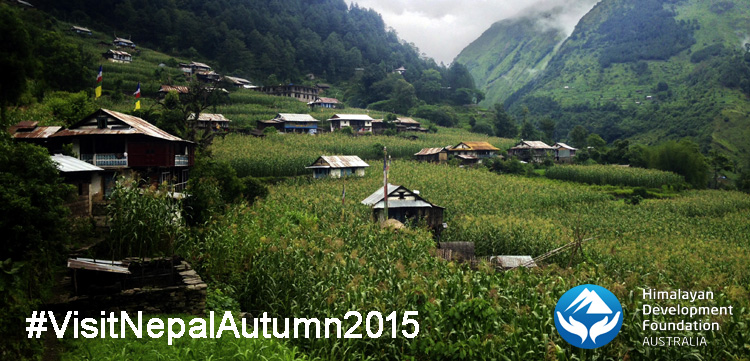Thoughts on Nepal - From Billi Bierling - HDFA Ambassador in Kathmandu
 Shortly after 25th April 2015 - the time when the earthquake shook Nepal - the Himalayan nation was all over the international news. Pictures of Kathmandu showing widespread destruction and suffering moved the world. For me, this was the first time in 11 years that I was not in Nepal on 25th April. I had left for Europe 4 days previously to attend a wedding so when I saw these pictures my heart was bleeding and I just wanted to go back to the country I have chosen to be my base camp.
Shortly after 25th April 2015 - the time when the earthquake shook Nepal - the Himalayan nation was all over the international news. Pictures of Kathmandu showing widespread destruction and suffering moved the world. For me, this was the first time in 11 years that I was not in Nepal on 25th April. I had left for Europe 4 days previously to attend a wedding so when I saw these pictures my heart was bleeding and I just wanted to go back to the country I have chosen to be my base camp.
I was lucky that the Swiss Humanitarian Aid Unit deployed me as part of their rapid response team and we touched down in Tribuvhan International Airport less than 36 hours after the quake. When we first got out of the airport it was eerie. I had never experienced Kathmandu like this - usually it is either loud and full of people or it is quiet after 9pm when the streets are deserted and most people have gone to sleep. This time it was different: there were people milling around everywhere but it was quiet - you could not even hear the bark of a dog, which is usually omnipresent.
The next morning I got on my bike and cycled through the city and initially I was not sure whether I was just ignorant to all the damage around me or whether it was really not as bad as what I had expected after having seen the devastating pictures on TV. In the interim, I have come to the conclusion that even though some of the destruction is not immediately obvious as some of the cracks in the big buildings are structural, Kathmandu has withstood this earthquake a lot better than portrayed on television. In fact, if you look at the pictures below you will see that parts of Kathmandu actually look better now than they did 1 ½ years ago.
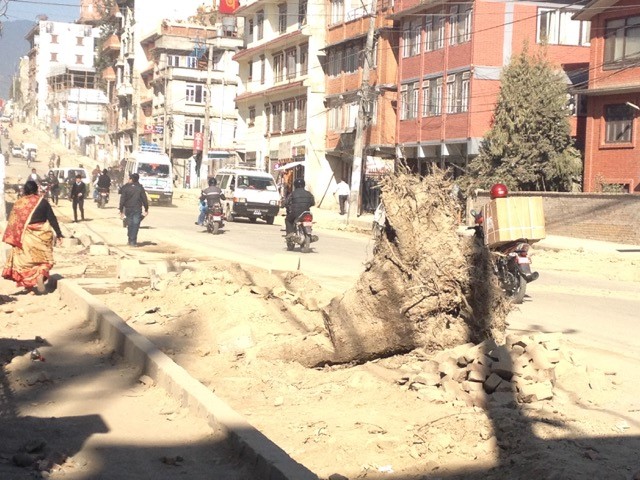
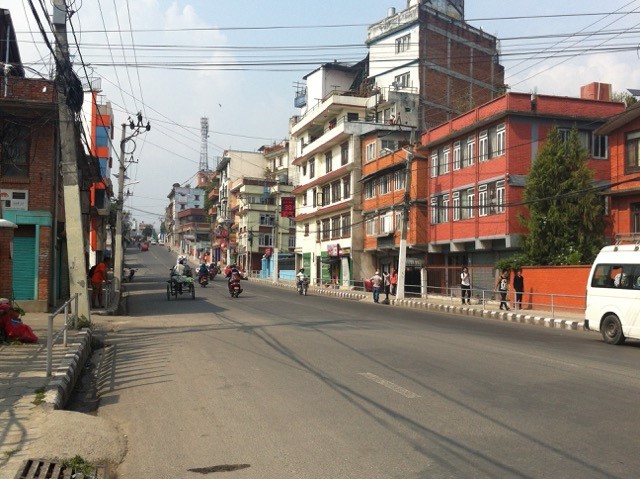
Kathmando October 2014 (left) and June 2015 (right)
Of course, I do not want to downplay the effects of the earthquake, the huge losses people have suffered, the challenges that lie ahead and its ramifications for the future. We all know that the road to recovery is a long one and even though the Himalayan nation is receiving international aid at the moment, many of the organisations are already starting to pack up as the first emergency phase is over. According to the United Nations, more than 700,000 people have so far received a tarp or a corrugated iron sheet, however, some of the villages are hard to reach and aid is slow to arrive.
So what’s next for Nepal? What will happen when a lot of the international aid is gone? Nepal needs two things in the long run: tools to generate its economy, like tourism, and education. With more than 36,000 classrooms completely destroyed and almost 17,000 partially damaged, rebuilding the education system is one of the most important tasks to secure a brighter future for the Himalayan nation. Without education, Nepal will not be able to rise again and even though the Ministry of Education has said it would reconstruct schools, I think international organisations can play a big part in this. For this reason, it is wonderful that the HDFA is aiming to support school reconstruction in
My next question is: what will happen to tourism? It is natural that those who had a trekking or cultural holiday planned in Nepal for April/May cancelled their trips, and this was definitely the right thing to do as Nepal currently needs its resources to cope with the effects of the earthquake. And I guess not many people have planned to come here in June/July/August as the monsoon season is not necessarily the most popular time for tourists to visit Nepal. But what about autumn? The Nepal economy is in a very dire situation and tourism is a very important tool, which can help improve the situation, however, the second earthquake on 12 May seems to have crushed people’s confidence and made many tourists cancel their trips.
 I would like to refrain from saying that most regions in Nepal are ‘safe’ as there is always a potential risk, wherever you go. However, I feel tempted to almost assure you that there is certainly no more risk than there was, let’s say, 12 months ago. Look at the Kanchenjunga region, for example. It has hardly been affected by the quake and can still be visited without any impact at all. And there is Humla, Mustang and Dolpo……all trekking areas that are pretty unaffected. And despite the devastating TV pictures of the destruction of the cultural sites in and around Kathmandu, not all is lost as many old temples have survived the quake. Pashupathi, which is the oldest Hindu temple in Nepal, has survived and so has Boudha, the most important Tibetan stupa outside Tibet. Even in places like Patan Durbar Square, which were reported to be destroyed shortly after the quake, the big temples are still standing. And when I cycled past some of these sites a few days ago, I could see that rebuilding was underway. The Nepal government has also announced that most of the sights will open again for tourists in June.
I would like to refrain from saying that most regions in Nepal are ‘safe’ as there is always a potential risk, wherever you go. However, I feel tempted to almost assure you that there is certainly no more risk than there was, let’s say, 12 months ago. Look at the Kanchenjunga region, for example. It has hardly been affected by the quake and can still be visited without any impact at all. And there is Humla, Mustang and Dolpo……all trekking areas that are pretty unaffected. And despite the devastating TV pictures of the destruction of the cultural sites in and around Kathmandu, not all is lost as many old temples have survived the quake. Pashupathi, which is the oldest Hindu temple in Nepal, has survived and so has Boudha, the most important Tibetan stupa outside Tibet. Even in places like Patan Durbar Square, which were reported to be destroyed shortly after the quake, the big temples are still standing. And when I cycled past some of these sites a few days ago, I could see that rebuilding was underway. The Nepal government has also announced that most of the sights will open again for tourists in June.
So, I urge you: please do not forget Nepal and come and visit in autumn 2015
 Shortly after 25th April 2015 - the time when the earthquake shook Nepal - the Himalayan nation was all over the international news. Pictures of Kathmandu showing widespread destruction and suffering moved the world. For me, this was the first time in 11 years that I was not in Nepal on 25th April. I had left for Europe 4 days previously to attend a wedding so when I saw these pictures my heart was bleeding and I just wanted to go back to the country I have chosen to be my base camp.
Shortly after 25th April 2015 - the time when the earthquake shook Nepal - the Himalayan nation was all over the international news. Pictures of Kathmandu showing widespread destruction and suffering moved the world. For me, this was the first time in 11 years that I was not in Nepal on 25th April. I had left for Europe 4 days previously to attend a wedding so when I saw these pictures my heart was bleeding and I just wanted to go back to the country I have chosen to be my base camp.


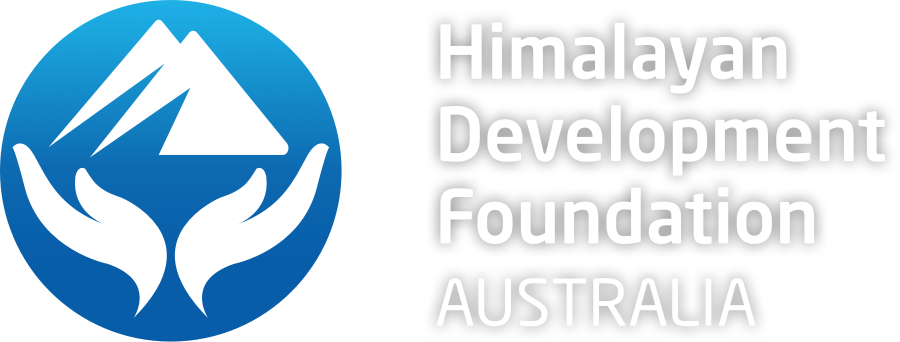
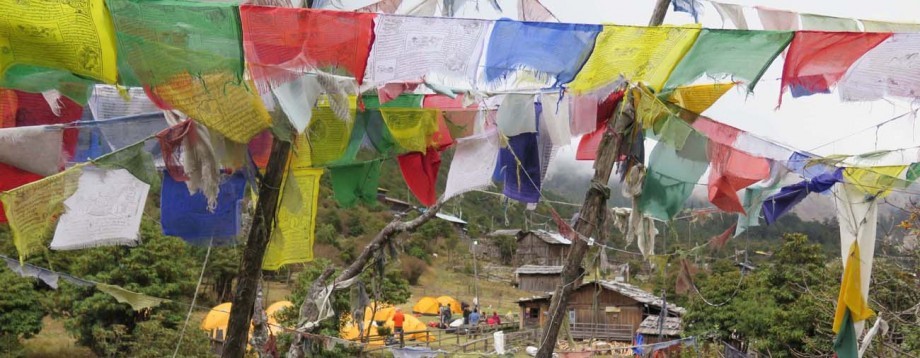
 I would like to refrain from saying that most regions in Nepal are ‘safe’ as there is always a potential risk, wherever you go. However, I feel tempted to almost assure you that there is certainly no more risk than there was, let’s say, 12 months ago. Look at the Kanchenjunga region, for example. It has hardly been affected by the quake and can still be visited without any impact at all. And there is Humla, Mustang and Dolpo……all trekking areas that are pretty unaffected. And despite the devastating TV pictures of the destruction of the cultural sites in and around Kathmandu, not all is lost as many old temples have survived the quake. Pashupathi, which is the oldest Hindu temple in Nepal, has survived and so has Boudha, the most important Tibetan stupa outside Tibet. Even in places like Patan Durbar Square, which were reported to be destroyed shortly after the quake, the big temples are still standing. And when I cycled past some of these sites a few days ago, I could see that rebuilding was underway. The Nepal government has also announced that most of the sights will open again for tourists in June.
I would like to refrain from saying that most regions in Nepal are ‘safe’ as there is always a potential risk, wherever you go. However, I feel tempted to almost assure you that there is certainly no more risk than there was, let’s say, 12 months ago. Look at the Kanchenjunga region, for example. It has hardly been affected by the quake and can still be visited without any impact at all. And there is Humla, Mustang and Dolpo……all trekking areas that are pretty unaffected. And despite the devastating TV pictures of the destruction of the cultural sites in and around Kathmandu, not all is lost as many old temples have survived the quake. Pashupathi, which is the oldest Hindu temple in Nepal, has survived and so has Boudha, the most important Tibetan stupa outside Tibet. Even in places like Patan Durbar Square, which were reported to be destroyed shortly after the quake, the big temples are still standing. And when I cycled past some of these sites a few days ago, I could see that rebuilding was underway. The Nepal government has also announced that most of the sights will open again for tourists in June.